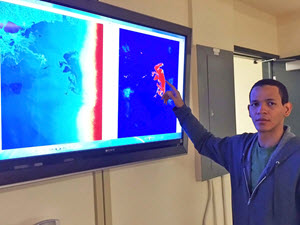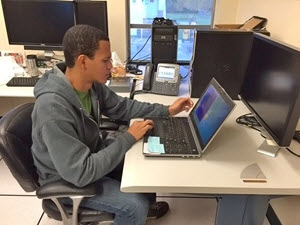
Juan demonstrates Synthetic Aperture Radar (SAR) data from the Deepwater Horizon incident. (Provided by Juan Pinales)
Juan Pinales is working on a computational modelling system that will aid oil spill monitoring efforts. He combines Synthetic Aperture Radar (SAR) data and oceanographic conditions recorded during the Deepwater Horizon incident to improve surface oil detection using a semi-automated machine learning method known as artificial neural networking.
This method will help the system’s computations “learn” to interpret new slick scenarios and identify sea surface oil more accurately as new data is entered and processed.
Juan is pursuing his Ph.D. in applied marine physics at the University of Miami’s (UM) Rosenstiel School of Marine and Atmospheric Science and is a GoMRI scholar working on the project Monitoring of Oil Spill and Seepage Using Satellite Radars. He explains how a lifetime fascination with making things work led him to this research.
His Path

Juan’s research requires many hours analyzing imagery to improve computational modeling calculations. (Provided by Juan Pinales)
As a child in the Dominican Republic, Juan chose class projects that allowed him to flex his creative muscles. He enjoyed science courses that applied theoretical knowledge to solve problems. “I loved to create and produce things, especially from an engineering perspective,” said Juan, “and I always wanted to work with computers.”
Juan’s family moved to New York while he was in high school, and he later enrolled in the materials and engineering science program at the State University of New York, Stony Brook. He enjoyed the chance to use materials to solve problems and created the Rumble Aide, an obstacle detection device for the blind, as his senior design project.
Juan briefly worked in industrial HVAC design after graduation, turning engineering schematics into three-dimensional products. The economic downturn sent him back to school as an Earth and Atmospheric Sciences graduate student (City College of New York) and a GED tutor (Bramson ORT College in Brooklyn), a role that honed his public speaking skills and raised his academic confidence. He continued mentoring younger students in the Summer High School Internship Program (CREST-SHIP), helping them learn STEM-related remote sensing applications and data analysis software, including QGIS and MATLAB.
While at the City College of New York, Juan received a graduate fellowship from the NOAA-Cooperative Remote Sensing & Technology (NOAA-CREST) program to monitor changes in Alaska’s freeze-thaw cycle using active and passive remote sensing instruments. This research taught him to incorporate SAR technology into his work. Wanting to continue this practice during his Ph.D. studies, Juan contacted Dr. Hans Graber, director of UM’s Center for Southeastern Tropical Advanced Remote Sensing (CSTARS) program, and joined Graber’s GoMRI-funded oil spill monitoring project.
His Work
SAR technology yields a complex, high-resolution map of the water’s surface, with oil slicks appearing noticeably darker than areas with no oil. Juan is creating an algorithm to help the modeling program correctly interpret the dark zones it sees. His goal is to have a product that needs minimal human input during a future spill.
Artificial neural networks are machine learning systems inspired by the human brain that can be trained with each new scenario. Juan analyzes SAR data using daily images and those from previous oil spills. He then updates the model’s program code to apply previous information to current scenarios, adding related inputs to teach the algorithm to differentiate between oil and things that look like oil but are not.
“The system is designed to recognize certain elements within an image. Things like wind fields can change the texture,” Juan explained. “The system is trained to recognize certain patterns and match those patterns to a desired output. Once the detection system is trained, the algorithm processes data and produces oil spill candidates.”
Juan presented an initial version of his project at the 2015 Gulf of Mexico Oil Spill and Ecosystem Science Conference in Houston, but says much work remains to be done. He communicates weekly with Dr. Graber and his CSTARS collaborators, John Hargrove and Michael Caruso, regarding his program’s progress. He’s currently working to reduce the time between data acquisition and output to aid responders in decision making and improve the system’s ability to distinguish natural seeps and certain weather conditions (low wind, surface roughness) from oil spills.
His Learning
Juan, though already familiar with field and satellite data, said that Dr. Graber had taken his understanding to a new level. “I am humbled that I have the opportunity to be here with people of this caliber,” he said of the UM research team working on the GoMRI project.
Juan did not know about ocean remote sensing techniques prior to attending UM. Working closely with marine field researchers has helped Juan to incorporate their methods into his project. “I’m engaging myself in different avenues so I can become a better researcher,” Juan explained, adding, “Every year I get better, and the algorithms perform better as a result.”
His Future
Juan’s focus is on improving his SAR oil-spill detection algorithm, preparing a draft of his first peer-reviewed paper, and finishing his Ph.D. program in 2018. He’s keeping his career options open, although he’s leaning towards a government or industry position.
“It can be difficult to see science as a viable path for a career,” said Juan. “But science has a lot of different applications. You can do things that are both important and relatable, things that shape government policy or change the market. You can have real world impact.”
Praise for Juan
Juan’s application caught Hans Graber’s eye because he had attended Graber’s alma mater, City College of New York. Familiar with the program, he knew that Juan would have the background to move into the challenging world of oil spill detection.
Graber recalled that during the Deepwater Horizon spill his team collected satellite data in real time from 21 sensors. Response teams were reacting in hindsight, never able to get ahead of the problem. He said Juan’s project could change that in a future spill. “Juan is a very enterprising and creative person,” said Graber. “He’s using a neural network, creating an algorithm with multiple sensors in mind.”
Graber compared Juan’s program to the human mind when it looks at a picture, saying most people would be able to look at an image of a forest and pick out the pine trees from the palmettos immediately even though their leaves are the same color. Graber explained that Juan’s algorithm, programmed to quickly make differentiations, will allow those monitoring our seas to immediately recognize emerging surface oil. “Juan’s project is very valuable,” Graber concluded, saying it would greatly decrease the environmental impacts of future spills.
The GoMRI community embraces bright and dedicated students like Juan Pinales and their important contributions. The GoMRI Scholars Program recognizes graduate students whose work focuses on GoMRI-funded projects and builds community for the next generation of ocean science professionals.
************
This research was made possible in part by a grant from The Gulf of Mexico Research Initiative (GoMRI). The GoMRI is a 10-year independent research program established to study the effect, and the potential associated impact, of hydrocarbon releases on the environment and public health, as well as to develop improved spill mitigation, oil detection, characterization and remediation technologies. An independent and academic 20-member Research Board makes the funding and research direction decisions to ensure the intellectual quality, effectiveness and academic independence of the GoMRI research. All research data, findings and publications will be made publicly available. The program was established through a $500 million financial commitment from BP. For more information, visit http://gulfresearchinitiative.org/.
